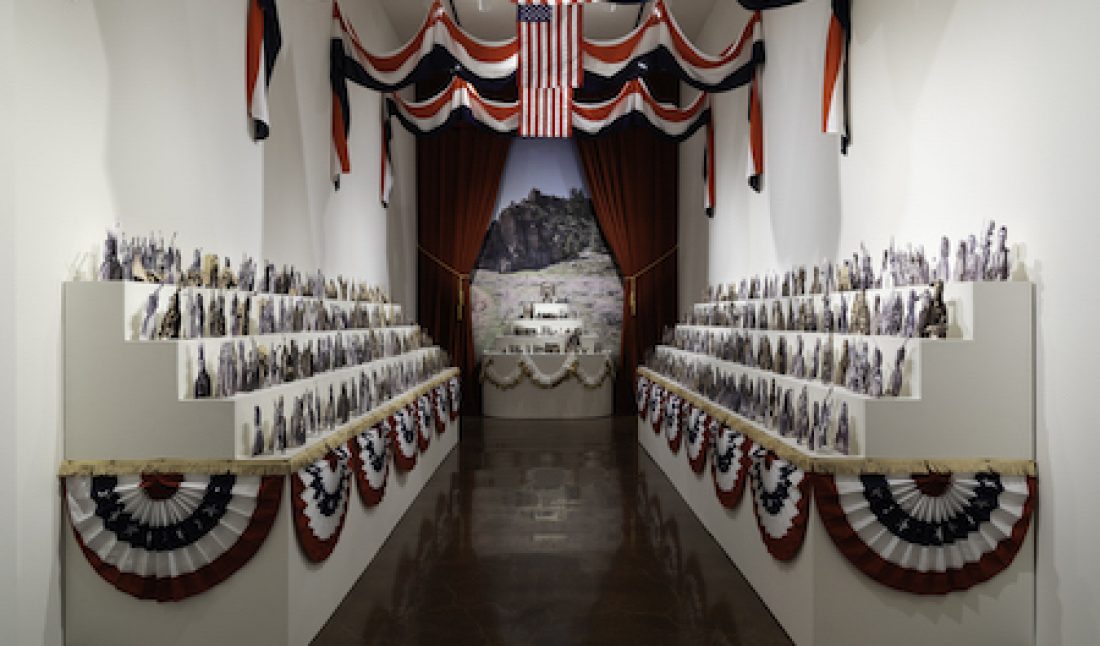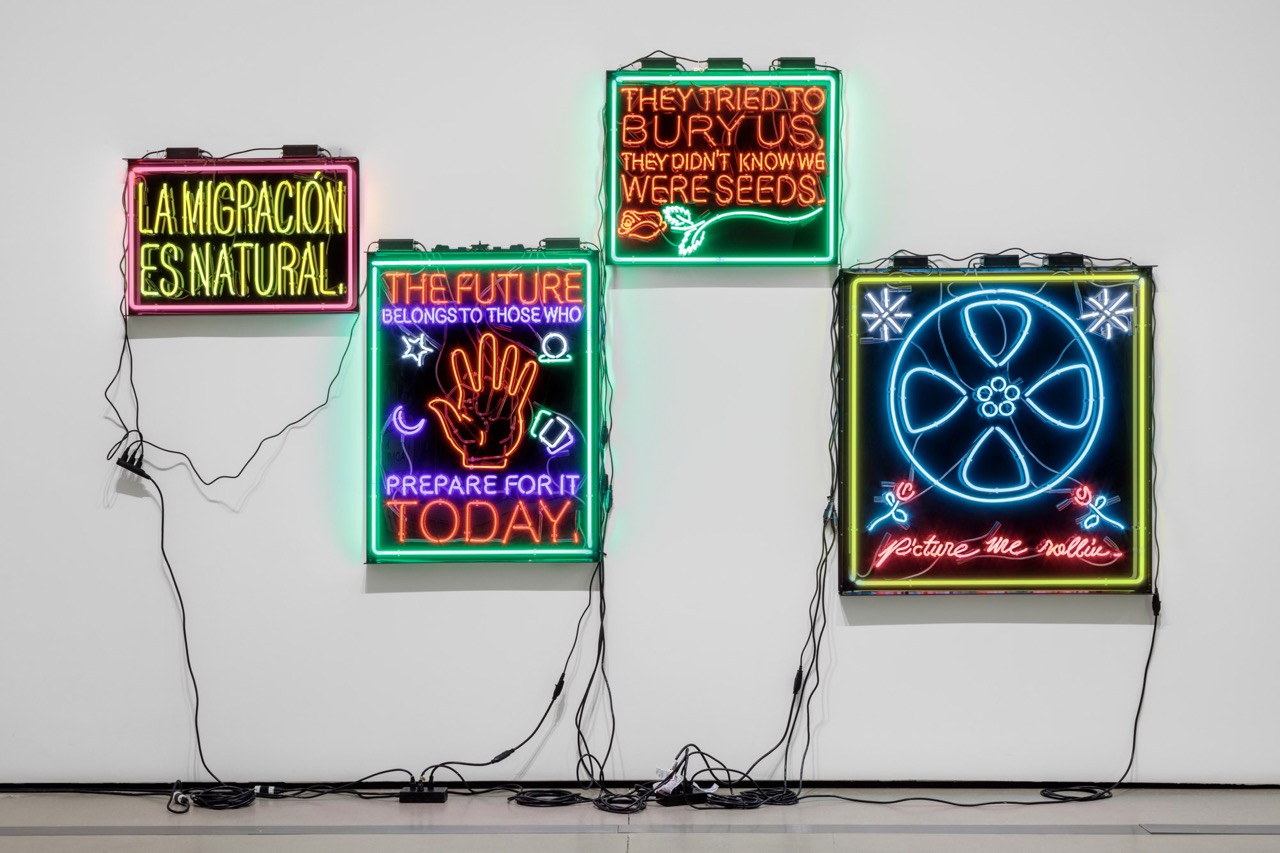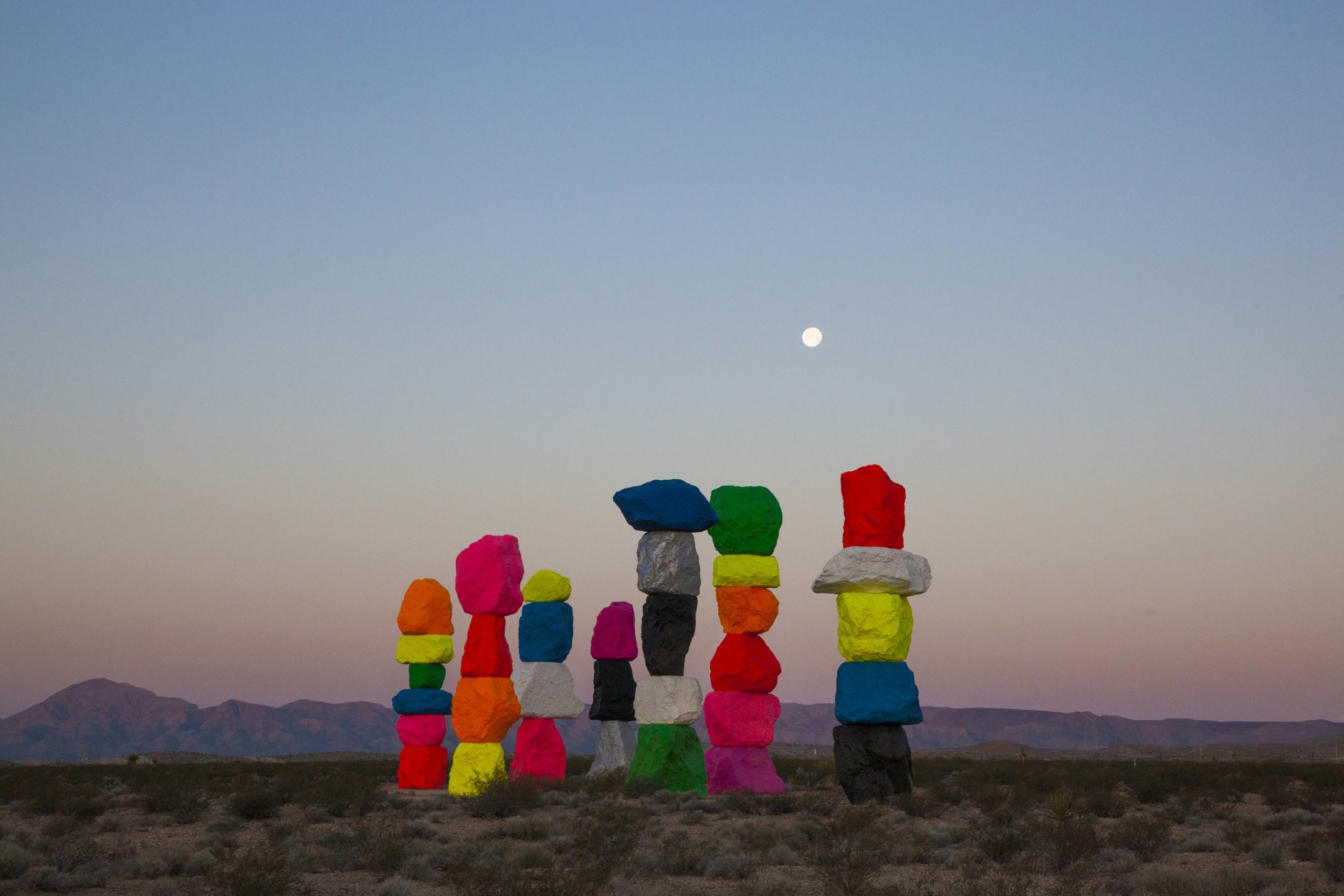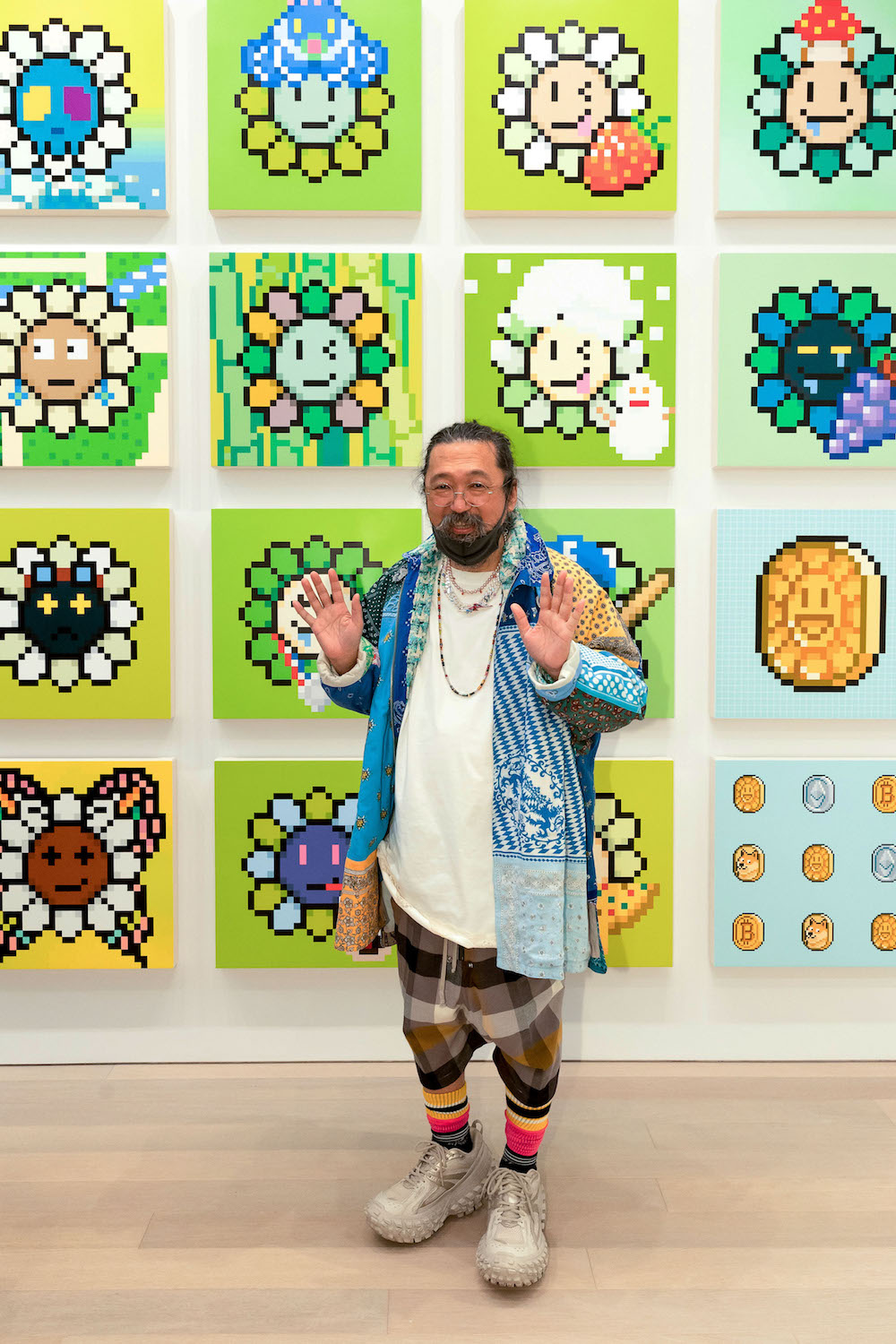Symmetrical geometric designs in red, yellow, green, blue, and white could be found covering JCDecaux bus shelters across New York, Chicago, and Boston last summer and fall. The images were created by the artist Wendy Red Star for the Public Art Fund, as part of a series entitled “Travels Pretty.” They were visual explorations of parfleches, painted rawhide bags created by Indigenous peoples of the North American Great Plains.
Red Star, who was raised on the Crow (Apsáalooke) reservation in Montana, often starts a body of work with an interest in learning more about the cultural objects and art of her community. Her work is guided by deep research, its end result often generously (both in quantity and in kind for the viewer) annotated—like the parfleche bus shelters—with discoveries, facts, and ideas found along the way. She takes us along in her pursuit of history and knowledge in an effort to gain and share access to that which has been taken, stolen, lost to time, or hidden away in high-walled institutions.
Her practice is personal, mapping connections to her ancestors as well as, for a time, actively collaborating with her daughter (now retired since age 11). Her immersive Indian Congress (2021), first installed at the Joslyn Art Museum in Omaha, Nebraska, later at The Broad, and now on view in Sharjah Biennial 15, reimagines the unprecedented but now little-known 1898 Indian Congress, which gathered more than 30 Native American tribes during Nebraska’s Trans-Mississippi Exposition. Projects like that, as well as her extensive engagement with Crow parfleche, are why, as she told Whitewall, she’s beginning to see herself as the archive.
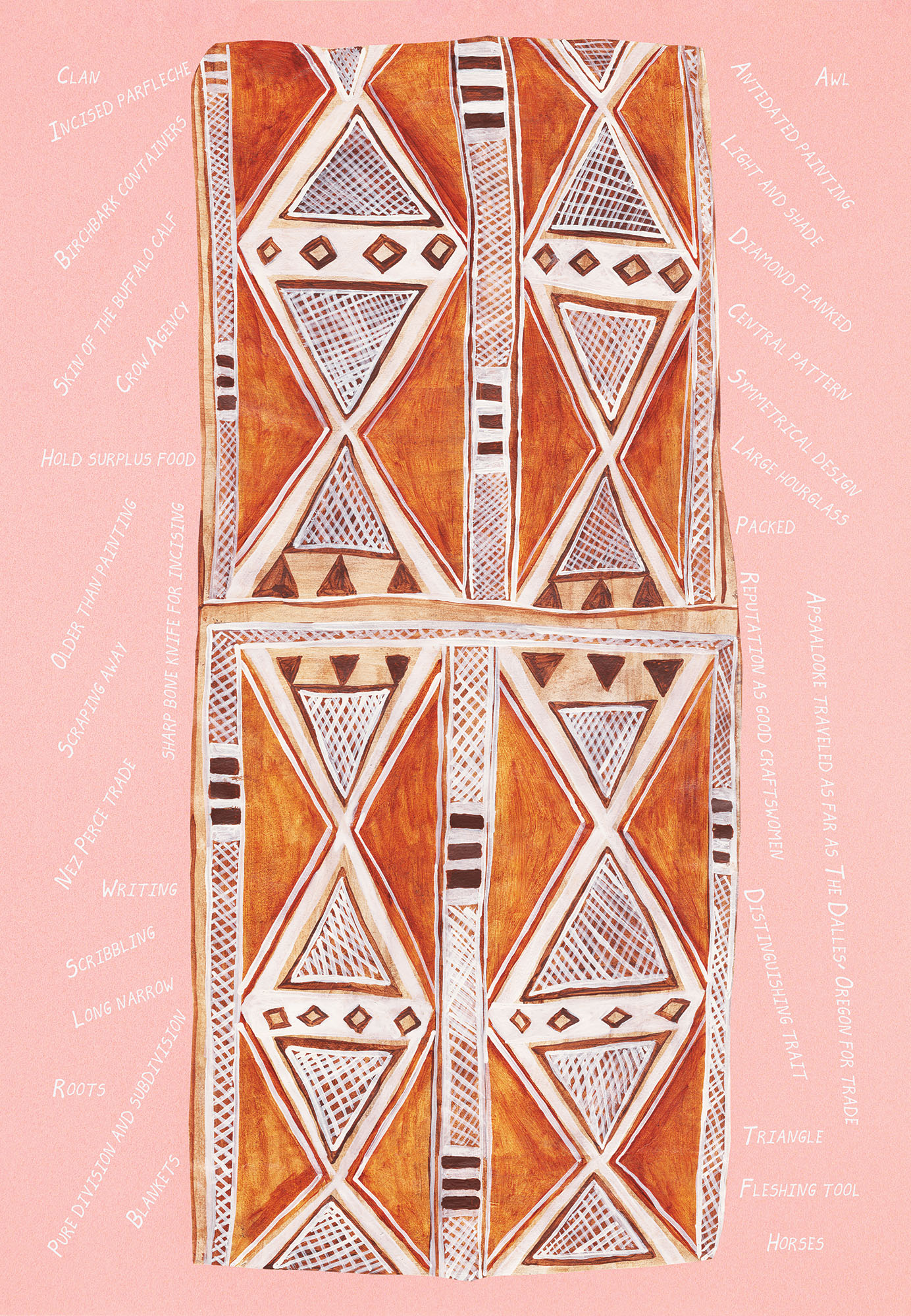 Wendy Red Star, “The Ground is her Medicine”; courtesy of the artist and Public Art Fund.
Wendy Red Star, “The Ground is her Medicine”; courtesy of the artist and Public Art Fund.
WHITEWALL: How did you approach your project with the Public Art Fund, the artwork series for bus shelters, “Travels Pretty”?
WENDY RED STAR: It’s in Boston, Chicago, and New York City. I can see Crow objects in almost every city that I’ve gone to that has Native American galleries. So I made that same bet looking into the cultural institutions in these cities, and each had Crow objects. From there I landed on these parfleche cases. A lot of the Native communities of the Plains region, even up into the coastal areas, would create these parfleche carrying cases that were utilitarian, and each community had its own colors and designs painted onto rawhide cases. For this project, they were perfect because they were traded, too. I really liked this idea of exchange and that they did end up all over the place.
As far as the aesthetic and the design, one of the things I remember my grandma saying is that when you make your designs, make sure that they are not complicated so they are simple and bold. Because then you can see them from the distance. These carrying cases, you could see them from a distance, and you would know which community was traveling based on their design. I love that idea of being on the bus and coming toward this image of the parfleche. Each of the paintings includes handwritten notes from researching parfleche cases.
The thing that I find to be really amazing is that it’s this history of painting. The whole archive, the whole history, and it’s right there for us. So I’m working on a project where I’ve collected over 170 Crow styles, and I’d like to try to paint 150 of Crow women’s paintings. I’ve been afraid of painting for so long, and my ancestors have been painting this whole time. And doing an amazing job.
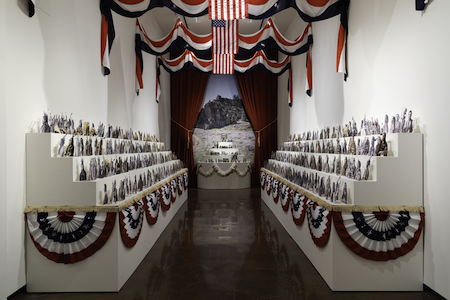 Wendy Red Star, “Indian Congress”; photo by Colin Conces, courtesy of the artist, the Joslyn Art Museum, and Sargent’s Daughters.
Wendy Red Star, “Indian Congress”; photo by Colin Conces, courtesy of the artist, the Joslyn Art Museum, and Sargent’s Daughters.
WW: You have a newly commissioned piece, Áakiiwilaxpaake (People of the Earth), on view at the Seattle Art Museum, in “American Art: The Stories We Carry,” a new installation of the American art galleries at the museum. Can you tell us about creating that work?
WRS: The museum approached me and said I could do a commissioned artwork that would have something to do with work in the collection in the America galleries. I started and was like, “Wait a minute, what is American art? Let’s google that and see what the definition is.” It came as “landscape paintings and realistic portraits.” And I was like, “Wow, that’s very interesting. Is that realistic of the world in which we live in? Or is it just a certain type of person’s world in which they live in and other things are disregarded out of that?”
Because I am missing in that scenario. I want to give people like me a sense that they are represented in the gallery, and I’ll do that in a combination of a landscape and portrait work.
So first, let’s start with the land, and talking about the landscape, Mount Rainier, Mount Tahoma comes up. And I wanted to represent Native people and primarily focus on Native women and children. So we made a call out to have Native women and children come and be photographed who live in the area or surrounding areas. I hired a Native woman photographer, Holli Margell. We had over 30 people come to the museum. It was a really beautiful day, so joyous. Everybody got the digital copies of their portrait sessions and physical print from that session and we invited them to the opening. It was really beautiful to have all of these Native women and children come to the museum. From there I took these portraits and created a light box we titled “People of Earth,” which is the way that Crow people say “Native American” or “Native People.”
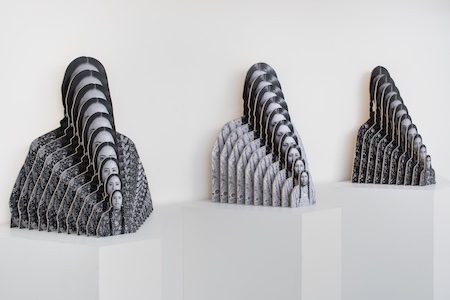 Wendy Red Star, “Amnía (Echo),” 2022, 66 1/2 x 98 1/4 x 19 in., archival ink on paper, board; photo by Nicholas Knight, courtesy of the artist and Sargent’s Daughters.
Wendy Red Star, “Amnía (Echo),” 2022, 66 1/2 x 98 1/4 x 19 in., archival ink on paper, board; photo by Nicholas Knight, courtesy of the artist and Sargent’s Daughters.
WW: Your work Indian Congress (2021) will be at the 2023 Sharjah Biennial. How did your research lead you to this immersive installation?
WRS: That work was originally produced for an exhibition at the Joslyn Museum in Omaha, Nebraska. It was about the historical Trans-Mississippi Exposition, part of the World’s Fair. That project was really amazing because part of the work that I do is researching and piecing things together. That project gave me another piece of the puzzle of my research. That work was based off the photographer who photographed the entire event, and his name was Frank Rinehart. Frank Rinehart also went to my reservation a year after the Trans-Mississippi Exposition and photographed my community about half a mile away from a sacred site I still go to and take my kid to. It’s amazing to stand in the landscape there and know exactly where he took those photos, know that that happened there. It felt really grounding and special.
WW: Your work is so research-driven, and you let us in on that journey as well. Why is it important for you to share that part of it with your audience?
WRS: That’s what inspires me, when an artist allows access to their process. I could watch process all day long. The final work is great, but the process is actually the work that I find rewarding and addicting—the reason why I keep doing it. Because it is nothing but an adventure. It’s always putting me in these unexpected places that I wouldn’t have encountered had I not done these projects. The other thing is I am truly learning, and therefore I want to explain that and share that, and so I’m glad that it’s interesting to other people and not just me.
WW: You’ve said, “I think what’s happening is that I’m becoming the archive.” What does that mean for you, for an artist to become the archive?
WRS: Part of it comes out of frustration and some of my experiences of feeling that I have to jump through a lot of hoops of different institutions or people who are in positions within those institutions who are not allowing access, or immediate access. It’s learning this knowledge that our community had—it was our knowledge to begin with. Because it became separate from our community, it’s gone dormant. I’m not saying that we don’t have it anymore. I do think it’s so ingrained within us that all we need is to be reunited with the materials or the images. It’s a terrible feeling and feels like trauma to me when a gatekeep is not allowing me access. So, part of that statement was me thinking that I want to become the archive then. I want for my community to always have access if they come to me or if they see my work or if they want to know things, that I am the archive.
And the archive for me has always been human. And part of that human aspect is that it is frustrating, and it doesn’t always get things right, and it makes assumptions. So you must always question the archive. So it is a true statement; I am becoming the archive, and the work when I die will be an archive. So how do I want that archive to be utilized? It maybe could sound egoist but it’s not—I want to find a way to make the archive more approachable and accessible.
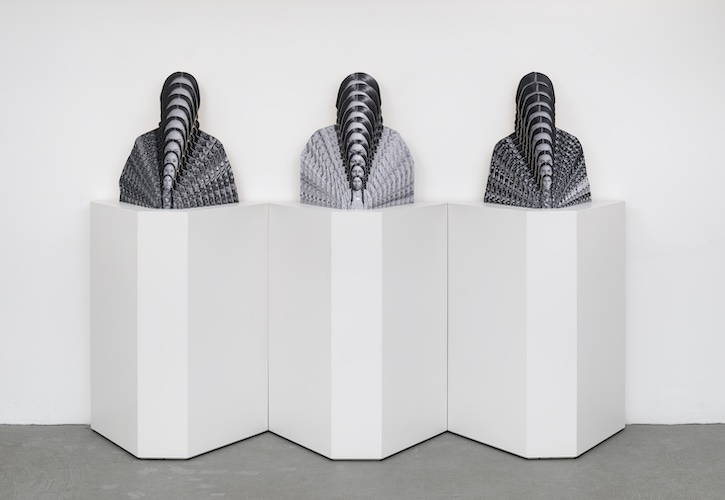 Wendy Red Star, “Amnía (Echo),” 2022, 66 1/2 x 98 1/4 x 19 in., archival ink on paper, board; photo by Nicholas Knight, courtesy of the artist and Sargent’s Daughters.
Wendy Red Star, “Amnía (Echo),” 2022, 66 1/2 x 98 1/4 x 19 in., archival ink on paper, board; photo by Nicholas Knight, courtesy of the artist and Sargent’s Daughters.
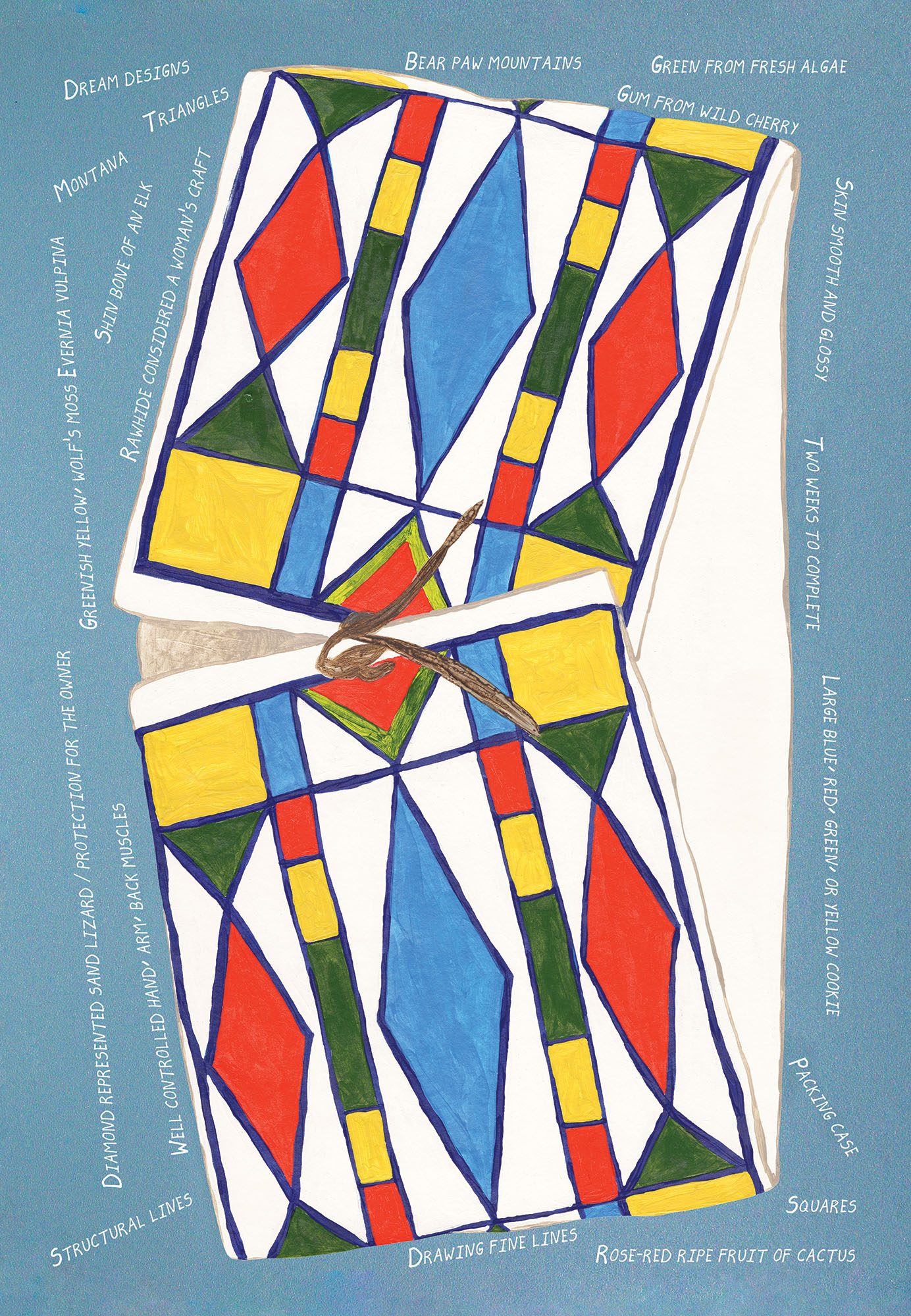 Wendy Red Star, “Brings Things Herself”; courtesy of the artist and Public Art Fund.
Wendy Red Star, “Brings Things Herself”; courtesy of the artist and Public Art Fund.







